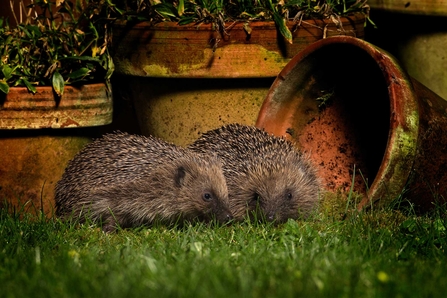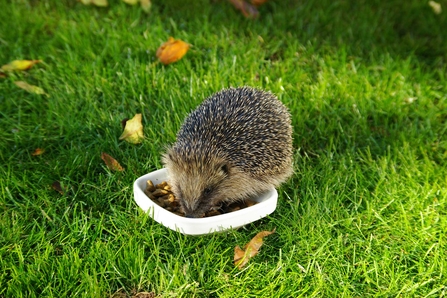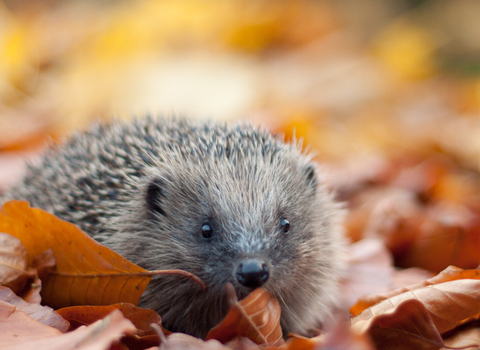Prickly characters
Small, round, brown and famously covered in spines, the Hedgehog is one of our most iconic mammals.
Hedgehogs are generalists, but the majority of their diet is made up of invertebrates such as beetles, caterpillars and sometimes slugs. Insect-rich lawns and flowerbeds make excellent feeding grounds at dusk, so a wildlife friendly garden will attract them to your patch.
Why don’t we see hedgehogs any more?
Hedgehogs are disappearing faster than tigers! Numbers have fallen by nearly a third since 2002. In 1950 the UK population was roughly 30 million, but fewer than one million hedgehogs are now thought to be left.
The decline of hedgehogs can be blamed on the loss of hedgerows, the over-management of parks and gardens, loss of green space to paving/decking and the use of chemical pesticides, leading to fewer insects for hedgehogs to eat.
How do I know if hedgehogs visit my garden?
Look out for hedgehog poo; medium-sized, black droppings consisting of bits of beetles and other insects, often found on the lawn and looks like a dark slug!

© Jon Hawkins
Have you seen a hedgehog?
Have you seen a hedgehog dead or alive? Please let us know!
We are looking for Surrey's hedgehog hotspots - the more we know about their distribution, the better we can help these precious creatures.
Help the hedgehog!
Follow our top tips for helping hedgehogs at home.
Hedgehog highways
Cut a small hole in the bottom of your garden fence to provide a corridor for hedgehogs to move between gardens. They can travel up to 2km a night!
Home sweet home
Build or buy a hedgehog house and locate it in a quiet corner of your garden.
Cut the chemicals
The majority of a hedgehog's diet is made up of invertebrates such as beetles, caterpillars and worms, so avoid the use of insecticides to help provide food for hungry hogs and attract these natural pest controllers.
It is also important to replace slug pellets with environmentally friendly alternatives as hedgehogs will sometimes eat slugs and may be inadvertently poisoned. The sale of metaldehyde slug pellets is now prohibited in the UK due to the threat they pose to a range of species, so please safely dispose of any remaining containers you may have.
What's for dinner?
Don’t be too tidy, leave a pile of leaves in a corner, keep a section of your lawn long and provide a log pile that will harbour lots of tasty invertebrate snacks.
How to build a minibeast log shelter
Feeding hedgehogs
Hedgehogs relish meat-based wet dog or cat food or plain kitten biscuits (no fish). Place in a shallow dish and put in a sheltered area of your garden at dusk. You can also use specialist hedgehog food but keep in mind that this isn't regulated and can vary in quality so always make sure to check Don't forget to put out water too.
NEVER give a hedgehog cow’s milk or bread as this is extremely harmful to them.

© Gillian Day
Hedgehogs & bonfires
Bonfires are very dangerous for hedgehogs as woodpiles are ideal places for shelter. Sadly many hedgehogs fall foul of unchecked bonfires and are killed because of it. But we can all take steps to ensure bonfires are as safe as possible.
- Build it on the same day that you will light it. The longer it’s left for, the more likely it is that a hedgehog will wander in.
- Place chicken wire one metre high, at an outward angle, all the way around the bottom while you're building it.
- If you have stored materials for your bonfire outdoors then move them to a different patch of ground.
- Always place the bonfire on open ground – never on a pile of leaves as a hedgehog may be hiding underneath.
- Always check the entire bonfire for hedgehogs before lighting it. They tend to hide in the centre and bottom two feet in particular.
- When checking, lift parts of the bonfire section by section using a pole or broom. Do not use a fork, spade or rake as this may injure a hedgehog.
- Use a torch to look inside the bonfire and listen for a hissing sound, as this is the noise that hedgehogs make when they are disturbed or distressed.
- Always light your bonfire from one corner, rather than in the centre, in order to give hedgehogs a chance to escape if they need to.
If you do find a hedgehog then move slowly and calmly. Pick it up with gardening gloves, along with any nesting material it may have been sitting in, and place it in a cardboard box lined with newspaper. Relocate the box to a safe location that is far from any fires or wait until the bonfire is over and dampen down the fire site with water before releasing the hedgehog under a bush or a log pile.
Hedgehog FAQ
Frequently asked questions about hedgehogs and their care.
I have seen a hedgehog out during the day
Hedgehogs are nocturnal, they sleep during the day and come out at night. If a hedgehog is out during the day it means that something is wrong and the hedgehog most likely needs help.
See a list of hedgehog rescue centres below.
I have a sick hedgehog
Handle the hedgehog with thick gloves as their spines can hurt and they may bite. Carefully pick the hedgehog up and put it in a high sided cardboard box with newspaper and an old towel. You could also add a hot water bottle (or a plastic drinks bottle) filled with warm water and wrapped in a towel to allow it to warm the hog gently. This will help an animal that is suffering from shock. The hedgehog should then be taken to a wildlife hospital or specialist rescue as soon as possible.
See a list of hedgehog rescue centres below.
What can I feed hedgehogs?
- Use plain kitten biscuits or meat-based wet dog or cat food. You can also use specialist hedgehog food but keep in mind that this isn't regulated and can vary in quality so always make sure to check.
- If you have a problem with cats eating the food, try placing the food under a brick shelter with a hedgehog-sized gap in it.
- If food isn’t eaten overnight, remove anything that will go off and replace it with fresh offerings in the evening. Research suggests that unpredictable supplementary feeding is beneficial e.g. moving the feeding spots around and scattering food in a more natural way.
- Avoid any interaction between dogs and hedgehogs. Sadly dog bites frequently cause injury or death to hedgehogs.
I have seen a small hedgehog in autumn
To survive the winter a hedgehog needs to weigh 600 grams by late autumn. If you see any small hedgehogs at this time, then take them to one of the rescue centres listed below. They are too small to hibernate and so need to be looked after to build up their fat reserves.
I have disturbed a hibernating hedgehog
If you come across a hibernating hedgehog, please try to carefully replace the nest material you disturbed. It's fairly likely the hog will come out of hibernation so please ensure you leave it some food and more importantly water, so it can quickly replenish its used stocks and get back to hibernating again.
I have found a nest of hoglets
A female hedgehog will leave her hoglets to go and find food, so if you find a nest of hoglets they have not necessarily been abandoned. If the hoglets seem warm, content and sleeping, please leave them alone. If they are cold, or making a high pitched “hungry” noise, or the nest has been destroyed, they will need to be brought to your nearest wildlife centre.
See a list of hedgehog rescue centres below.
Hedgehog rescue centres
If you find a sick, injured or orphaned hedgehog please contact one of the organisations below:
Wildlife Aid – North Surrey
Randalls Farm House, Randalls Rd, Leatherhead KT22 0AL
Telephone 24hr Emergency Helpline - 01372 360404 (calls charged at local rate)
Harper Asprey – North East Surrey
Windlesham, Surrey, GU20 6YW
Telephone 01344 623106 8am-4pm
Tel: 01932 889182
Hart Wildlife Rescue – South West Surrey
Unit 9, Lower Soldridge Business Park, Medstead Nr Alton, Hampshire GU34 5JF
Telephone 0913 580 0001 open from 9am - 5pm, 7 days a week. (Calls cost 61p plus a standard network rate charge. This charge is to aid with funding. Alternatively call 01420 562335.
The British Hedgehog Preservation Society also have a detailed list of rescues and animal hospitals across the country. You can contact them on 01584 890 801.

